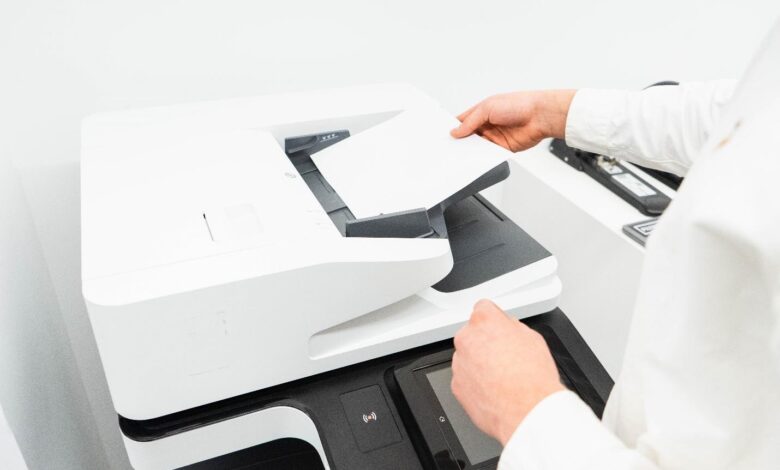Making the move from paper-based processes to a modern digital system

We’re living in a time of less paper. The overall volume of paper consumption has declined significantly in the past couple of years, which can be explained by a shift to digital media and paperless communication across developed economies. Businesses are looking for ways to cut down on their paper consumption, motivated by challenges such as lowering their carbon footprint, decreasing expenses, and enhancing the security of information. Soon enough, paper will be a thing of the past. The rise of computers has made it possible for people to dream about going paperless. Less paper waste translates into less deforestation.
If your existing processes are paper-based, you should transfer them to a digital management system. Indeed, this is time-consuming and demands a great deal of effort, yet you’ll be happy you made the switch. Storing documents electronically makes it easier to maintain records. If you’re serious about setting up a paperless office, this information will come in handy.
Benefits of banishing paper documents for good
By getting rid of paper documents, you can reap a great many benefits. These are just some of the advantages that you can enjoy by digitizing your documents.
Enhanced data quality
Poor data quality results in operational chaos, inaccurate analytics, and ill-conceived business strategies. When you collect information using paper forms, there’s always the risk of incomplete, incorrect, or inaccurate entries during manual transcription. To ensure and sustain data quality, it’s recommended to digitize your existing documents and, in the future, rely exclusively on electronic files. Technology alone isn’t the solution, but using digital documents can certainly add value and doesn’t create an extra burden for people in the company.
Real-time reporting
These days, there’s a need to use information in real-time, so organizations can’t rely on traditional reporting anymore. Real-time reporting provides better extraction of data from databases and websites. Export formats include but aren’t limited to PDF, Excel, PowerPoint, RTF, HTML, CSV, SVG, XML, and PostScript. At any rate, real-time reporting is simple to accomplish when all the records are entered into a modern system. Compiling a list of transactions, for instance, can take hours, even days, using the old paper system.
Improved collaboration and security
Digital documents are sharable, which means that they can seamlessly eb distributed across digital media using cloud-based file syncing and sharing. File sharing is an important part of document collaboration. A PDF file, for example, can be shared as a link in any browser, on any device. Speaking of which, if it’s necessary to remove errors and mistakes, you need to get a PDF editor to be able to edit, alter, annotate, or subtract from the document.
Most PDF editors are apps that work on Windows and Mac, although there are desktop apps as well. A good program like PDFChef allows you to edit and save on an existing PDF. In case you didn’t already know, digital records are a lot safer as opposed to their printed counterparts. Digital documents make it possible to grant or restrict access, create trails, and easily retrieve them. Only the right people will have access to information. Rules can be set based on various criteria, such as user, group, department, etc.
How to create an effective digital system
Converting files to a digital environment will help you meet your needs and requirements the use of digital workflows isn’t limited to one industry. So, it doesn’t matter if you run a law firm or a healthcare organization. Keep in mind these considerations when attempting to make the transition from paper-based processes to a modern digital system.
Bring everyone together and discuss the process
Before taking action, it’s recommended to gather everyone in the company and let them know about your plans. To put it simply, it’s necessary to keep people informed and make information available at all times during the process. Many problems can arise due to failure of communication. That’s why it’s necessary to take a considered approach. Have an in-depth conversation about digital transformation and facilitate improved performance. Most importantly, make yourself available for questioning. People should be able to reach you.
Gather all the documents you want to digitize
Taking into account the long list of benefits associated with digitizing documents, don’t waste any more time and scan the most important documents you have. Examples of files that you should digitize are:
- Contracts
- Tax returns
- Medical records
- Insurance policies
- Partnership agreements
- Profit and sales reports
Have all the important documents at your fingertips. They should be in an organized and structured environment.
Use a scanner (or a mobile app)
Scanning helps enhance organization, protecting documents through electronic filing, translating documents into digital formats, and reducing paper storage. When you get tired of using the scanner, use the scanning app embedded in Windows 10. If the scanner is plugged in and turned on, you can go right ahead. Click the Preview button and make sure the scan appears correctly. Equally, you can take a picture with the camera built-in your phone or tablet.
Use the scanner to create a PDF. You can control the way the scanned images are filtered or compressed for the PDF. You might want to customize the settings for higher-quality images smaller file sizes, and so on. For bulk document scanning, you can deploy professional document imaging services. Outsourcing is much less expensive, just so you know. It’s better than trying to handle things on your own.
Safely store your documents
It’s important to have a plan for the documents you create. Ideally, you should have several copies in separate locations. Duplicates can be uploaded to a cloud service such as Dropbox or Google Docs. Nonetheless, a specialized document can help you stay on top of things and maintain an efficient archive. It can be helpful, but it certainly isn’t mandatory. When selecting a document storage solution, take into consideration aspects like customer experience, cloud business accounts, and security protocols. Regardless of whatever tool you decide to use, make sure it’s secure, affordable, and feature-rich.


